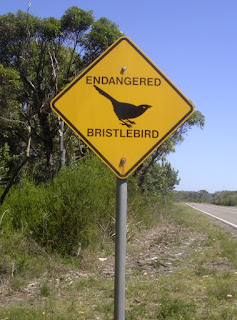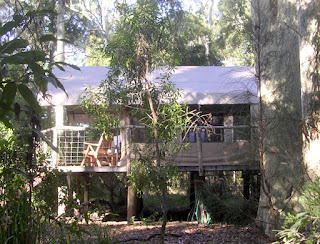Cronulla lies to the south of Botany Bay, at the end of a long, curved beach that mostly faces due east. The Pacific swells come rolling in directly to the beach, creating a surfers' heaven. The town is about 20 kms. from the centre of Sydney and not far from Sydney Airport; planes are constantly landing or taking off over the sea. Train services run into Sydney, so we can assume there is a lot of commuting, especially by people who like to get their surfing in before they go to work. When we took an early morning walk on the day we left, there were dozens of surfers at 7:00 am.
The southern part of Cronulla looks out onto Gunamatta Bay, which is sheltered from the waves of the ocean and is stuffed with expensive boats at anchor or at the jetties of the expensive houses that line the shore. Across the bay is Bundeena, a small town at the northern end of Royal National Park, and several coastal hikes start from the beaches and cliffs of the town. If you have two days to spare, you can hike the whole length of the coastline down to Bald Hill Overlook, at the southern end of the Park, where our rental car had exploded the day before.
But to get to Bundeena by car by driving around Gunamatta Bay takes about an hour, as the road has to circle far inland around the bay. Alternatively, there is a ferry service from Cronulla that runs on the half hour through the day, and we took it at 8:30 am to cross to Bundeena for a coastal hike.
When the ferry came in from Bundeena, crowds of schoolchildren disembarked to go to school in Cronulla, and when we got to Bundeena another, larger crowd of kids, swarmed onto the boat.
When the ferry came in from Bundeena, crowds of schoolchildren disembarked to go to school in Cronulla, and when we got to Bundeena another, larger crowd of kids, swarmed onto the boat.
We followed the hiking trail across beaches and along the cliffs out to Point Hacking, where the bay meets the ocean, and we thought we should memorialize our last sight of the Pacific swell crashing against the coast.
Further on the trail turned inland through thick vegetation, and we began to be conscious of SPIDERS, and as everyone knows--Australia is full of poisonous spiders--the Sydney Tunnel-web, the Redback, the bird-eating (yes) Tarantulas, the Huntsman, and the Black Widow. The spiders we encountered were BIG, and their enormous webs were strung right across our path. Sometimes the network of webs was huge, creating a sort of web-city, occupied by a large number of spiders. Difficult to photograph, but we did our best.
After the hike, we had our final swim from one of the beaches, before going back to catch the ferry. During the walk along the beach I could not resist taking some ‘abstracts’ of patterns in the rocks.
And Joan liked the mosaic of the Kookaburra at the ferry station.
On the ferry back, it seemed at one point that we would have to repel boarders, as a whole fleet of surf-board paddlers bore down on the ferry.







































